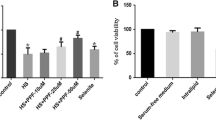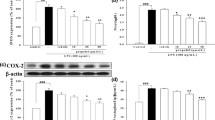Abstract
Propofol has been reported to protect vascular endothelial cells against oxidative stress and dysfunction, but the underlying mechanisms are not clear. In this study, we studied hydrogen peroxide (H2O2)-induced oxidative stress and cell dysfunction in human umbilical vein endothelial cells (HUVECs) and especially, their modulation by propofol. HUVECs were treated with different concentrations (0.1 and 0.5 mM) of H2O2 for different times (1, 3, and 6 h). Then HUVECs were pretreated with different concentrations of propofol (10, 25, and 50 μM), followed by H2O2 treatment (0.5 mM, 3 h). In another set of experiments, we pretreated cells with p38 mitogen-activated protein kinase (p38 MAPK) inhibitor SB203580, followed by H2O2 treatment (0.5 mM, 3 h). After treatment, oxidative stress, p38 MAPK phosphorylation, transcription factor NF-κB activation, nitric oxide synthase (NOS) expression, nitric oxide (NO) production, and monocyte adhesion were measured. We observed H2O2 treatment significantly induced oxidative stress, which could be attenuated by 25 μM propofol pretreatment. In addition, H2O2 treatment significantly induced p38 MAPK phosphorylation, NF-κB activation, NOS expression, and NO production. More importantly, our study showed these H2O2-induced changes were attenuated by propofol or SB203580 pretreatment. Further, we measured monocyte adhesion as a marker of endothelial cell dysfunction. H2O2 increased the adhesion of monocytes to HUVECs, and propofol pretreatment reduced the adhesion in a fashion similar to SB203580. We concluded that propofol, by inhibiting p38 MAPK and NF-κB activity, decreasing NOS expression, reducing NO production, could protect HUVECs which are exposed to oxidative stress and becoming dysfunctional.








Similar content being viewed by others
References
Griendling KK, FitzGerald GA (2003) Oxidative stress and cardiovascular injury: part II: animal and human studies. Circulation 108:2034–2040
Chen J, Mehta JL (2004) Role of oxidative stress in coronary heart disease. Indian Heart J 56:163–173
Peng Z, Luo M, Ye S, Critchley LA, Joynt GM, Ho AM et al (2003) Antioxidative and anti-endotoxin effects of propofol on endothelial cells. Chin Med J 116:731–735
Wang B, Luo T, Chen D, Ansley DM (2007) Propofol reduces apoptosis and up-regulates endothelial nitric oxide synthase protein expression in hydrogen peroxide-stimulated human umbilical vein endothelial cells. Anesth Analg 105:1027–1033
Aarts L, van der Hee R, Dekker I, de Jong J, Langemeijer H, Bast A (1995) The widely used anesthetic agent propofol can replace alpha-tocopherol as an antioxidant. FEBS Lett 357:83–85
Tesauro M, Thompson WC, Moss J (2006) Effect of staurosporine-induced apoptosis on endothelial nitric oxide synthase in transfected COS-7 cells and primary endothelial cells. Cell Death Differ 13:597–606
Xu JJ, Wang YL (2008) Propofol attenuation of hydrogen peroxide-mediated oxidative stress and apoptosis in cultured cardiomyocytes involves haeme oxygenase-1. Eur J Anaesthesiol 25:395–402
Kobayashi K, Yoshino F, Takahashi SS, Todoki K, Maehata Y, Komatsu T et al (2008) Direct assessments of the antioxidant effects of propofol medium chain triglyceride/long chain triglyceride on the brain of stroke-prone spontaneously hypertensive rats using electron spin resonance spectroscopy. Anesthesiology 109:426–435
Gulcin I, Alici HA, Cesur M (2005) Determination of in vitro antioxidant and radical scavenging activities of propofol. Chem Pharm Bull 53:281–285
Kahraman S, Kilinç K, Dal D, Erdem K (1997) Propofol attenuates formation of lipid peroxides in tourniquet-induced ischaemia-reperfusion injury. Br J Anaesth 78:279–281
Eriksson O (1991) Effects of the general anaesthetic propofol on Ca2(+)-induced permeabilization of rat liver mitochondria. FEBS Lett 279:45–48
Mehta JL, Li D (2001) Epinephrine upregulates superoxide dismutase in human coronary artery endothelial cells. Free Radic Biol Med 30:148–153
Saldeen T, Li D, Mehta JL (1999) Differential effects of alpha-and gamma-tocopherol on low-density lipoprotein oxidation, superoxide activity, platelet aggregation and arterial thrombogenesis. J Am Coll Cardiol 34:1208–1215
Leikert JF, Räthel TR, Müller C, Vollmar AM, Dirsch VM (2001) Reliable in vitro measurement of nitric oxide released from endothelial cells using low concentrations of the fluorescent probe 4,5-diaminofluorescein. FEBS Lett 506:131–134
Li D, Mehta JL (2000) Antisense to LOX-1 inhibits oxidized LDL-mediated upregulation of monocyte chemoattractant protein-1 and monocyte adhesion to human coronary artery endothelial cells. Circulation 101:2889–2895
Navapurkar VU, Skepper JN, Jones JG, Menon DK (1998) Propofol preserves the viability of isolated rat hepatocyte suspensions under an oxidant stress. Anesth Analg 87:1152–1157
Acquaviva R, Campisi A, Murabito P, Raciti G, Avola R, Barcellona ML et al (2004) Propofol attenuates peroxynitrite-mediated DNA damage and apoptosis in cultured astrocytes: an alternative protective mechanism. Anesthesiology 101:1363–1371
De La Cruz JP, Zanca A, Carmona JA, de la Cuesta FS (1999) The effect of propofol on oxidative stress in platelets from surgical patients. Anesth Analg 89:1050–1055
Delogu G, Antonucci A, Moretti S, Marandola M, Tellan G, Signore M et al (2004) Oxidative stress and mitochondrial glutathione in human lymphocytes exposed to clinically relevant anesthetic drug concentrations. J Clin Anesth 16:189–194
Murphy PG, Davies MJ, Columb MO, Stratford N (1996) Effect of propofol and thiopentone on free radical mediated oxidative stress of the erythrocyte. Br J Anaesth 76:536–543
Mathy-Hartert M, Deby-Dupont G, Hans P, Deby C, Lamy M (1998) Protective activity of propofol, Diprivan and intralipid against active oxygen species. Mediators Inflamm 7:327–333
Demiryurek AT, Cinel I, Kahraman S, Gogus N, Kanzik I (1998) Propofol and intralipid interact with reactive oxygen species: a chemiluminescence study. Br J Anaesth 80:649–654
Honegger P, Matthieu JM (1996) Selective toxicity of the general anesthetic propofol for GABAergic neurons in rat brain cell cultures. J Neurosci Res 45:631–636
Gao J, Zhao WX, Zhou LJ, Zeng BX, Liu D, Chen ZQ (2006) Protective effects of propofol on lipopolysaccharide-activated endothelial cell barrier dysfunction. Inflamm Res 55:385–392
Evans JL, Goldfine ID, Maddux BA, Grodsky GM (2002) Oxidative stress and stress-activated signaling pathways: a unifying hypothesis of type 2 diabetes. Endocr Rev 23:599–622
Waldron RT, Rey O, Zhukova E, Rozengurt E (2004) Oxidative stress induces protein kinase C-mediated activation loop phosphorylation and nuclear redistribution of protein kinase D. J Biol Chem 279:27482–27493
Allaouchiche B, Debon R, Goudable J, Chassard D, Duflo F (2001) Oxidative stress status during exposure to propofol, sevoflurane and desflurane. Anesth Analg 93:981–985
Acknowledgment
This project was supported by the National Nature Foundation of China (Grant# 30772078).
Author information
Authors and Affiliations
Corresponding author
Rights and permissions
About this article
Cite this article
Chen, J., Gu, Y., Shao, Z. et al. Propofol protects against hydrogen peroxide-induced oxidative stress and cell dysfunction in human umbilical vein endothelial cells. Mol Cell Biochem 339, 43–54 (2010). https://doi.org/10.1007/s11010-009-0368-y
Received:
Accepted:
Published:
Issue Date:
DOI: https://doi.org/10.1007/s11010-009-0368-y




